To prepare for the smart kitchen revolution, start by evaluating your current kitchen setup. Identify areas where technology can boost efficiency, such as inventory-tracking fridges and smart ovens. Gradually introduce one or two smart appliances while ensuring they’re compatible and within your budget. Focus on ergonomic designs for better workflow and stay informed about emerging trends that enhance sustainability. Explore how personalizing your kitchen can maximize functionality and create a smarter cooking environment. There’s much more to discover!
Key Takeaways
- Assess your current kitchen layout and workflow to identify areas for technology integration and improved efficiency.
- Prioritize essential smart appliances based on cooking habits, dietary preferences, and budget for a gradual upgrade.
- Research compatibility among smart appliances to ensure seamless communication and interoperability in your kitchen.
- Embrace ergonomic design principles to enhance comfort and workflow efficiency during meal preparation.
- Stay informed about the latest smart kitchen technologies and sustainability trends through newsletters and community insights.
Assessing Your Current Kitchen Setup
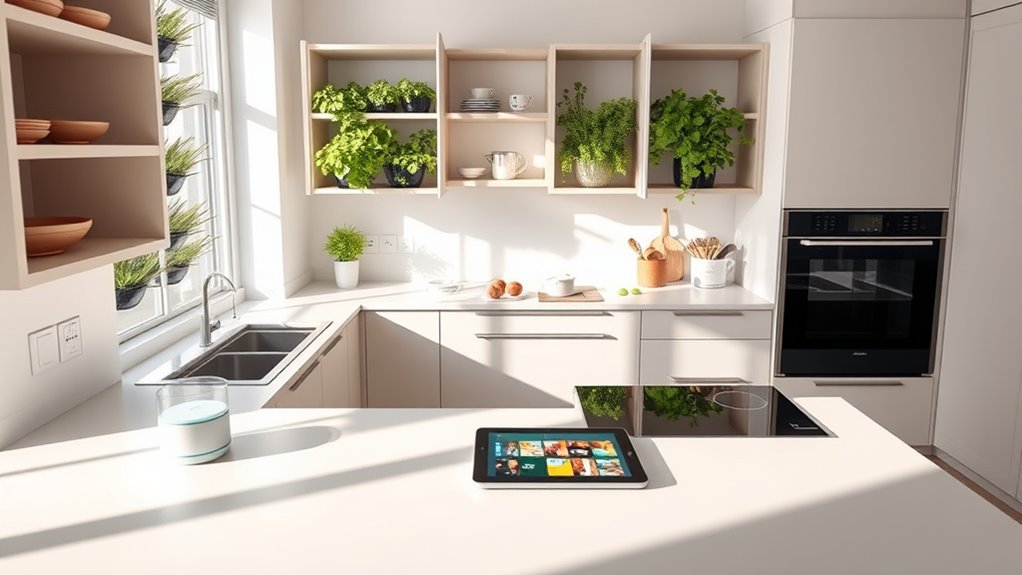
When you assess your current kitchen setup, start by evaluating the layout and workflow to pinpoint areas where smart appliances can boost efficiency and cut down on clutter.
Look at your existing appliances for compatibility with smart technologies, like Wi-Fi connectivity, which can enhance their functionality.
Assess your current appliances to see if they can integrate smart technologies, enhancing their performance with Wi-Fi connectivity.
Take inventory of your food storage needs by checking your pantry and fridge; this will help you select smart appliances that effectively monitor and manage supplies.
Consider your cooking habits and dietary preferences, as these will guide your choices—think multifunctional tools or smart ovens.
Finally, review your budget and prioritize essential smart appliances, ensuring they promise long-term efficiency while leaving room for future upgrades as technology evolves. Additionally, focus on integrating energy-efficient appliances that can significantly reduce your utility bills while enhancing kitchen performance.
Identifying Areas for Technology Integration
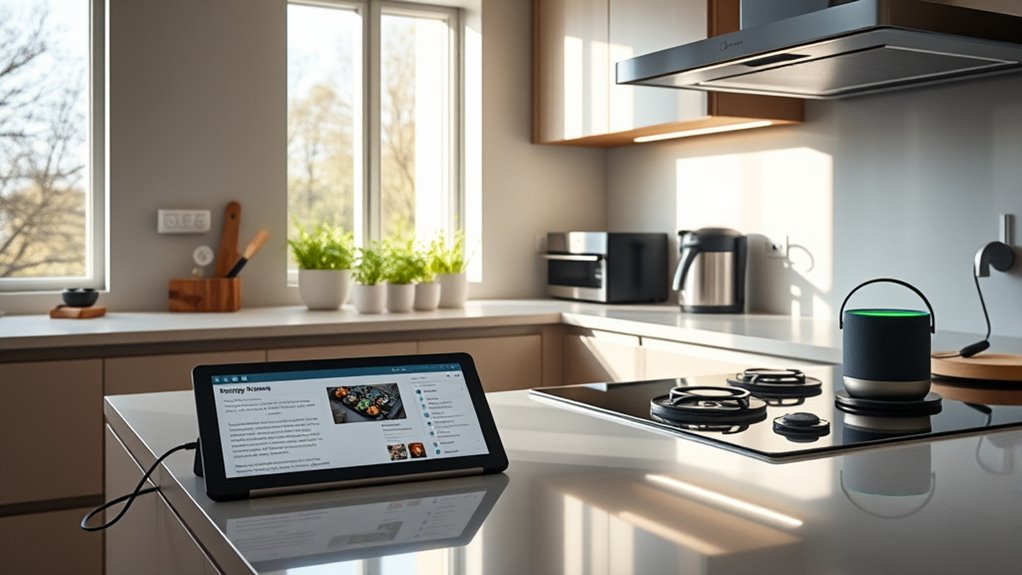
After evaluating your current kitchen setup, it’s time to pinpoint areas where technology can enhance your cooking experience.
Consider upgrading outdated appliances to smart options that offer convenience and efficiency. Here are some key areas to explore:
- Smart Refrigerators: Implement inventory tracking systems to monitor food expiration dates and reduce food waste.
- Voice Commands: Integrate voice-activated assistants to control multiple devices, making cooking tasks hands-free and easier.
- Energy-Efficient Appliances: Look for smart kitchen technology that adapts to your usage patterns, lowering energy consumption and saving on utility costs. Additionally, consider incorporating air purification systems into your kitchen for improved indoor air quality, which can further enhance your cooking environment.
Gradually Introducing Smart Appliances
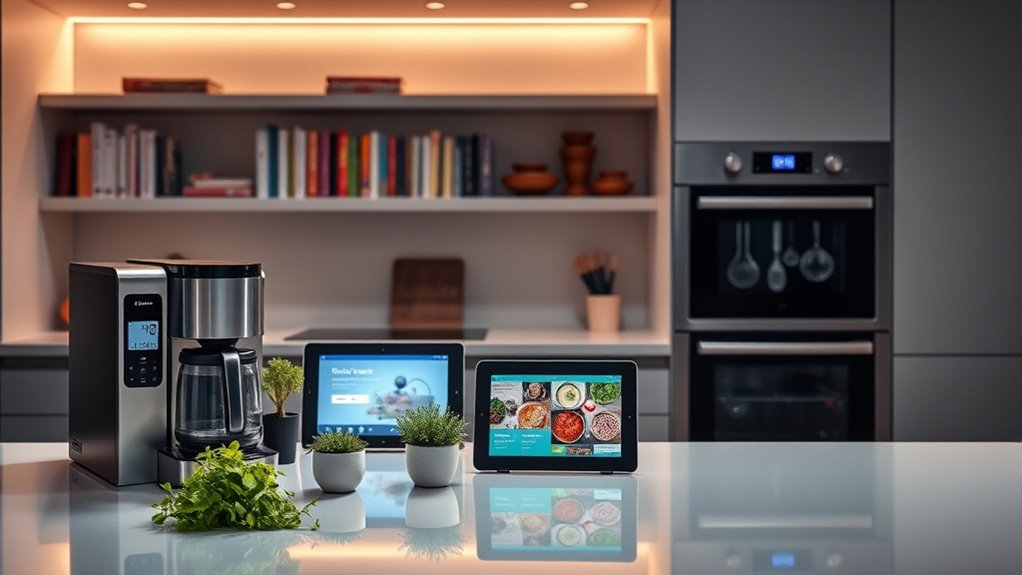
To get started with smart appliances, first assess your kitchen’s needs and workflow, pinpointing areas that could use a tech upgrade.
Prioritize essential appliances, like a smart refrigerator or oven, that will provide the most immediate benefits.
Assess Current Kitchen Needs
As you consider enhancing your kitchen, evaluating your current layout and workflow is essential for identifying how smart appliances can boost efficiency and convenience.
Start by pinpointing areas where you struggle with meal planning or experience food waste.
- Assess your kitchen layout to see where a smart refrigerator could optimize storage and inventory tracking.
- Think about smart appliances that can automate tasks, saving you time during meal prep.
- Check compatibility among devices to guarantee a seamless smart kitchen ecosystem.
Prioritize Essential Appliances
How can you make the most of your kitchen upgrade? Start by prioritizing essential kitchen appliances that incorporate smart technology. A smart refrigerator is a fantastic first choice, helping you save money on food and energy while simplifying meal planning with inventory tracking and suggestions.
Next, consider a smart oven, like the Thermador Pro Harmony, which allows remote control and precise cooking for perfect baking. Don’t forget a smart dishwasher that operates efficiently and sends alerts when cycles finish, reducing your workload.
Finally, a multifunctional tool like the Thermomix TM6 can enhance meal prep with guided instructions. Focus on interoperability, ensuring your smart appliances communicate seamlessly to create a cohesive kitchen ecosystem. Additionally, consider the potential for water conservation through smart appliance technology, which can lead to significant savings and sustainability in your kitchen.
Gradual Integration Strategy
Upgrading to a smart kitchen doesn’t have to happen all at once. Start by choosing one or two smart appliances that fit your needs, like a smart refrigerator to help with meal planning and reduce food waste.
This gradual integration allows you to familiarize yourself with control and automation features without feeling overwhelmed.
- Research compatibility with your existing kitchen gadgets and Wi-Fi network.
- Monitor the performance of each appliance to evaluate efficiency and benefits.
- Design an ergonomic layout that enhances workflow and accessibility. Additionally, consider the energy-efficient appliances that can lower overall energy consumption while integrating seamlessly into your kitchen.
Establishing a Budget and Ensuring Compatibility
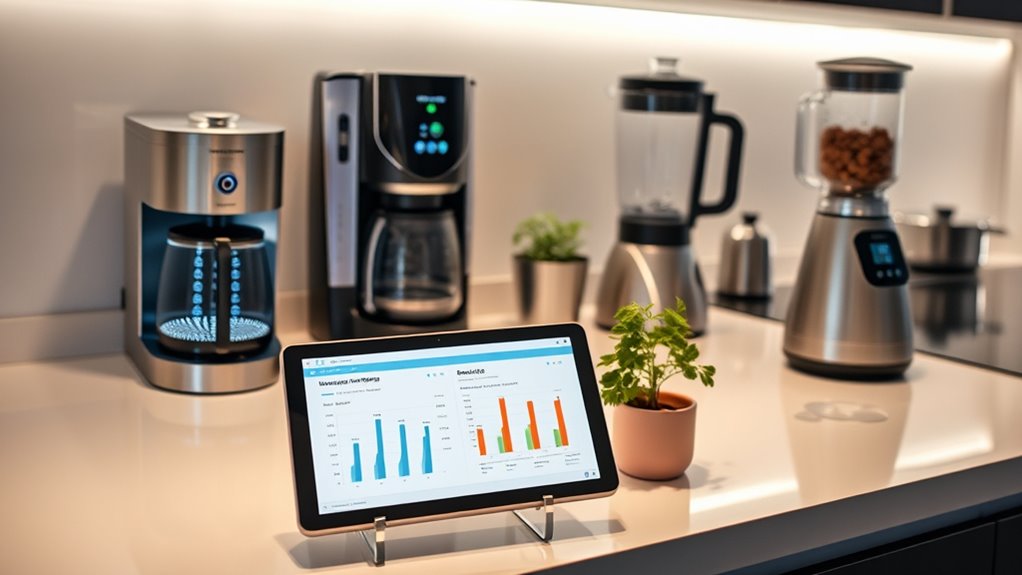
While planning your smart kitchen, it’s vital to establish a budget that goes beyond just the initial costs of appliances.
Consider potential savings on energy bills and reduced food waste over time, as these can greatly impact your finances.
Compatibility among your smart appliances is essential; make sure they support common connectivity standards like Wi-Fi or Bluetooth for seamless integration.
Don’t forget to research the long-term value of durable products to avoid frequent replacements.
Factor in possible installation costs, such as electrical upgrades or Wi-Fi enhancements, to optimize performance.
Finally, remember that some mobile apps or subscription services may require additional investment, so include these in your overall budget to fully enjoy your smart kitchen experience. Additionally, look for energy monitoring features that can help track usage and further reduce your utility bills.
Emphasizing Ergonomic Design for Enhanced Workflow
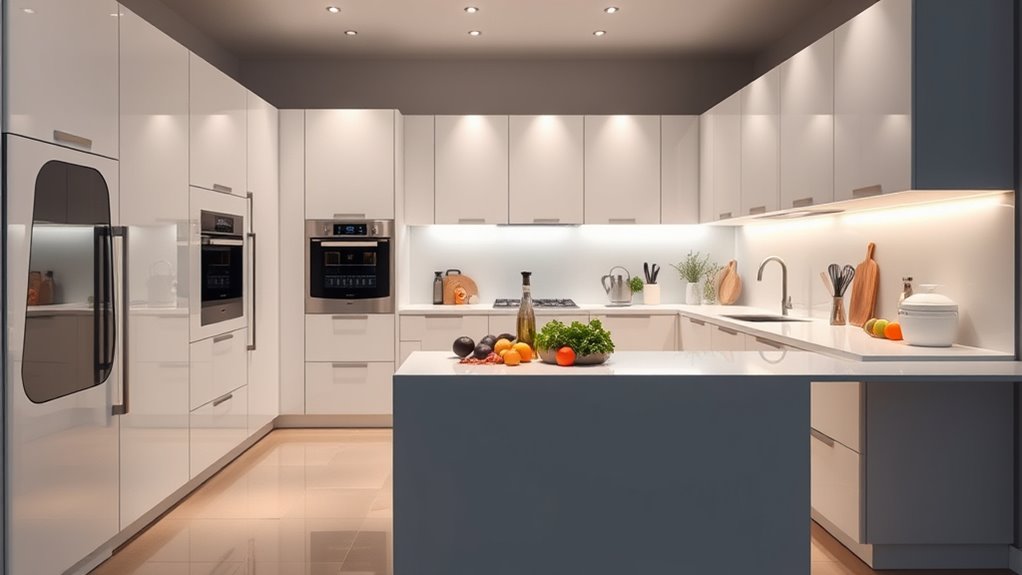
To create a truly efficient smart kitchen, you need to prioritize ergonomic design that enhances your workflow. This approach minimizes unnecessary movement and strain during meal preparation, making tasks smoother and more enjoyable.
Consider these key features:
- Adjustable countertops and cabinets: Customize your workspace to accommodate users of varying heights, promoting comfort.
- The work triangle layout: Position your stove, refrigerator, and sink in a triangular configuration to optimize workflow and reduce travel distance.
- Pull-out shelves and task lighting: Maximize accessibility and visibility, allowing you to reach items without bending or stretching, thereby reducing physical strain.
Implementing these ergonomic elements will make your smart kitchen not just functional, but also a more accessible and enjoyable space for cooking.
Staying Informed About Evolving Trends

As the smart kitchen landscape evolves, staying informed about emerging trends is essential for maximizing your cooking experience. Keep an eye on innovations in smart devices, especially those linked to the Internet of Things. These advancements can streamline meal planning and cooking precision. Engage in online forums to learn about effective kitchen technology and share experiences. Developing a structured routine can also help you adapt to these new technologies more seamlessly.
| Trend Category | Key Focus | Benefits |
|---|---|---|
| AI Integration | Meal Planning | Enhanced cooking precision |
| Energy Efficiency | Sustainable Appliances | Reducing food waste |
| Waste Management | Smart Storage Solutions | Improved organization |
| Community Insights | User Experiences | Timely product recommendations |
Subscribe to newsletters for updates on sustainability trends and new features that enhance your kitchen’s efficiency.
Personalizing Your Kitchen for Maximum Functionality and Sustainability
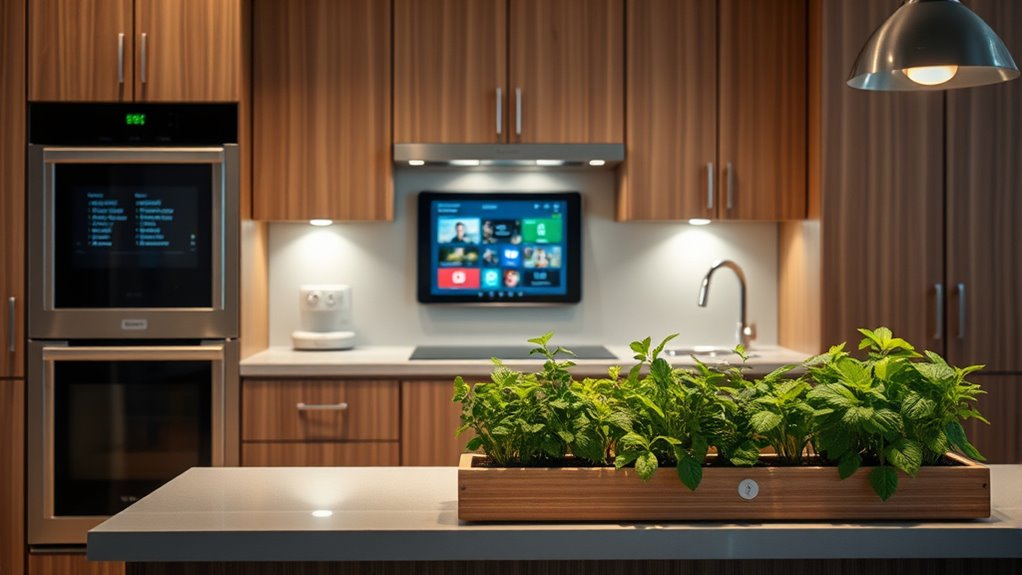
Personalizing your kitchen not only enhances its functionality but also promotes sustainability, making your cooking experience more efficient and enjoyable.
Enhancing your kitchen’s functionality fosters sustainability, making cooking more efficient and enjoyable.
By integrating smart appliances, you can streamline your kitchen tasks while reducing waste. Consider these options:
- Invest in smart fridges with inventory tracking to alert you about expiration dates.
- Use energy-efficient technologies, like smart dishwashers that adjust water usage, to lower utility costs.
- Incorporate smart ovens that can be preheated remotely for added convenience.
These choices not only make daily cooking easier but also support a greener lifestyle. Additionally, the transition to electric appliances aligns with broader environmental sustainability efforts, as seen in Tesla vehicles.
Personalizing your kitchen with these innovations guarantees you adapt to emerging technologies, ultimately creating a space that’s both efficient and eco-friendly.
Frequently Asked Questions
What Are the Disadvantages of a Smart Kitchen?
A smart kitchen has its disadvantages. You might face high initial costs that make you hesitate before investing.
Dependence on technology can lead to frustrating malfunctions or failures when you need appliances most. Privacy concerns can arise from data collection, making you wary of security breaches.
Limited compatibility between devices can complicate your experience, and if you’re not tech-savvy, the learning curve might discourage you from fully enjoying the benefits of your smart kitchen.
How to Set up a Smart Kitchen?
So, you wanna turn your kitchen into a futuristic wonderland? Start by analyzing how you use your space—because we all know that tripping over the cat while cooking isn’t the dream.
Choose smart appliances like a fridge that knows you’re out of milk and an oven you can control from your couch. Make sure they all talk to each other, and don’t forget to download the necessary apps to manage everything from your phone!
How Do You Prepare a Kitchen Before Cooking?
To prepare your kitchen before cooking, start by clearing and cleaning your workspace. Sanitize all surfaces and remove any clutter.
Gather your ingredients and equipment, measuring out spices and prepping vegetables to stay organized.
Familiarize yourself with your appliances, ensuring they’re connected and ready to use.
Finally, set up a cooking playlist for some entertainment, and prepare tools like timers and scales to optimize efficiency during your cooking process.
What Is an Example of a Smart Kitchen?
A great example of a smart kitchen is one equipped with the Samsung Family Hub refrigerator.
It features built-in cameras that help you see what’s inside without opening the door, tracking expiration dates to reduce food waste.
Pair it with the Thermador Pro Harmony smart oven, which lets you monitor cooking temperatures remotely, and you’ve streamlined meal prep.
Adding a Moen smart faucet gives you hands-free water control, making cooking even more efficient.
Conclusion
Embracing the smart kitchen revolution might seem intimidating, but it doesn’t have to be overwhelming. By taking small, manageable steps, you can seamlessly integrate technology into your cooking space. Remember, you don’t need to replace everything at once—start with one or two smart appliances that fit your lifestyle. This gradual approach not only enhances efficiency but also makes your kitchen more enjoyable. So, immerse yourself and discover how these innovations can transform your culinary experience!









